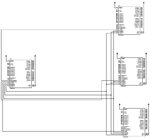Prayuktibid
Newbie level 6
I want to communicate with multiple slaves using SPI protocol. I takes different SlaveSelect lines for respective slave.. I have very beginner in this field I don't understand how to proceed... but I have tested data transfer between single master and single slave before going to multiple slaves.
I made a plan that I will do it by SPI interrupt Instead of SPI polling.. here the problem I dont understand how to handle interrupt ISR for each slave... please give some suggestion with example code.
Here my schematics..

I made a plan that I will do it by SPI interrupt Instead of SPI polling.. here the problem I dont understand how to handle interrupt ISR for each slave... please give some suggestion with example code.
Here my schematics..

